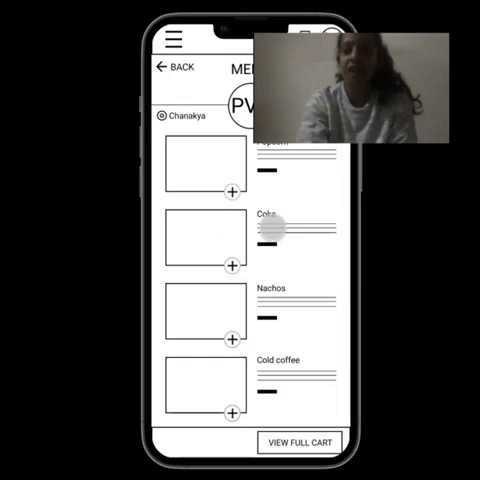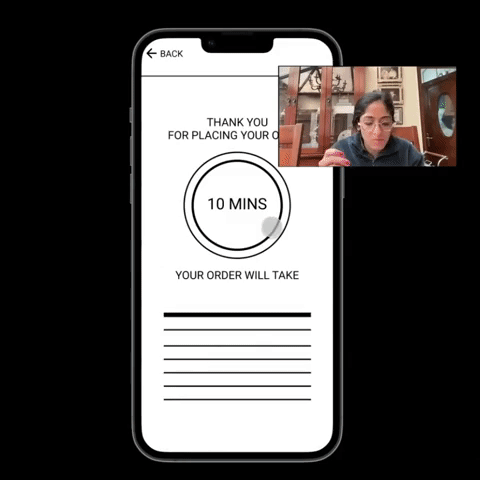
Introduction
I love watching movies and always end up eating something in the hall. I hate missing movie scenes because of the endless queues and noticed others feel the same way. So I thought this would be a perfect first project for my UX design portfolio! 14.6 crore Indians watched at least one film in a theatre in 2019 out of which 58% of the theatrical reach comes from Urban India. The YouGov survey conducted among over 1,000 respondents in India, shows that every 1 in 6 cinemagoers watches a film every week.
My Role in the project: Start to end, research, ideation, prototyping and conducting usability studies.
PROJECT DURATION: JUNE 2021 - FEBRUARY 2022. | NEW DELHI - INDIA
This project is divided in 3 stages:
Research
Design

Test
Understand user needs and pain points
Business Goals
Personas and Customer Journey
Competitive Analysis
Wireframes
Prototypes
Design System
Usability Test Study
Iterate, test and repeat
1. Research
Understanding the user
As there isn't an app in India which caters to this need, I conducted introductory interviews with people to understand the needs and incentives of this product.



After interviews and secondary research I derived on the following insights:
This app is beneficial for all types of user and will allow them to plan their food delivery on the seat. It benefits someone who is tech savvy and has no time to waste as well as someone who has all the time but struggles with technology.
Business Goals:
This app will also benefit the cinema chains, as it will increase counter sales and reduce on floor rush.




Competitive Analysis
The closest direct competitor of the app currently would be BookMyShow. However the app allows users to prebook their snacks while they are purchasing movie tickets.
Zomato and Swiggy on the other hand are India's top food delivery apps, but they do not deliver in cinema halls and are tied up with stand alone restaurants. This gives us a great opportunity to study their model and apply that in a different environment.
Zomato
As per the results of a survey on Indian food delivery apps conducted by Rakuten insight in August 2021, Zomato was the most popular food delivery app. I have done a competitive analysis on some direct and indirect brands and derived key takeaways on why Zomato is leading or what pointers should I be carrying with me to build the SnackApp.
BACK END
ANALYSIS
Key Takeaways
Zomato has exceptionally good quality imagery as compared to other apps.
Extremely clear call to actions
Minimal designs and good colour contrast
Informative in a fun way. Such as the zomato delivery icon to track order.

2. Design
Wireframes and Prototypes
I created some paper wireframes after reviewing my interviews and defining goals and problem statements. I then used the most promising one into digital wireframes and prototypes.
Low Fidelity Prototype - SnackApp
Below is my first round of low fidelity prototype. I conducted a usability test for the app.


HOME PAGE WITH CINEMA SCREEN OPTIONS TO SELECT FROM
FOOD ITEMS TO SELECT

CUSTOMISE SELECTED ITEMS

ORDER SUMARY WHERE YOU CAN ADD SCREEN AND SEAT NUMBER

PAY,MENT PAGE

MY ORDER PAGE TO TRACK YOUR LIVE ORDER!
3. Test
Goal of the study:
I conducted a UX Research Usability test, to check if my low fidelity prototype was feasible and the customers were able to complete the transaction easily. I also wanted to see if other areas in the app were easy to navigate also.
Study details:
Research questions
-
Can the user complete the transaction on the App?
-
Are users able to successfully reach the profile page?
-
Can the users figure how to track their order easily?
-
Were the users able to edit their order once placed?
Participants
5 participants
Participants between the ages of 22 - 35 who reside in metropolitan and suburb areas. They are all frequent movie watchers who order snacks in the hall.
Methodology
15-20 minutes
Zoom call meet
Moderated usability study on Zoom with screen share and prompts
Users were asked to order food on a low-fidelity prototype



After the study was conducted I collected data in one place and identified themes. I did this by the help of an Affinity diagram.


I identified 3 themes after my usability test.
Participants were getting stuck at the cart.
-
4 out of 5 participants were not being able to figure out where the cart was.
-
2 out of 5 participants felt there should be a prompt after adding an item to the cart.
“Once you add an item, it just goes back to the first page, so I don’t understand what happened?”- Pallavi
Participants were getting confused finding their current order.
-
4 out of 5 participants felt that the Current Order should be separate from Order History
-
3 out of those participants suggested that it should be like Zomato. They have a separate page for live orders.
"if you see a Zomato or Swiggy, order history and orders are aways different. I think you should have them separate"- Sarah
Participants want
pre-order option.
-
3 out of 5 participants said they would like to have a pre-order option.
“People also may want to add a "delivery slot" for themselves. That way in the interval, i’d be first in the order”- Vedica
My research insights from this activity was:
Cart Prompt
Users need a Cart Page/ Prompt once they add an item. They also need a more obvious CTA to follow to complete transaction.
P0
Create a cart page right after Add to Cart which further given customers actions to follow.
Order Page
Users want a dedicated Order page for current orders. To view and edit which should be separate from order histories.
P0
Create a separate current order page
Pre Order
There should also be a pre ordering option. A slot which you can add when you want the food to be delivered to you.
P1
Create a pre-ordering slot option in the Order Summary Page.
Iterated Low Fidelity Prototype - SnackApp
I then iterated my designs based on my insights.







I made the top and bottom bars consistent.
Combined tacking and editing order in a page and gave an option to view that at the bottom bar.
Add to cart prompt page with clear CTA.
Created a pre-order option along with delivery
Combined tracking and editing order in a page.

